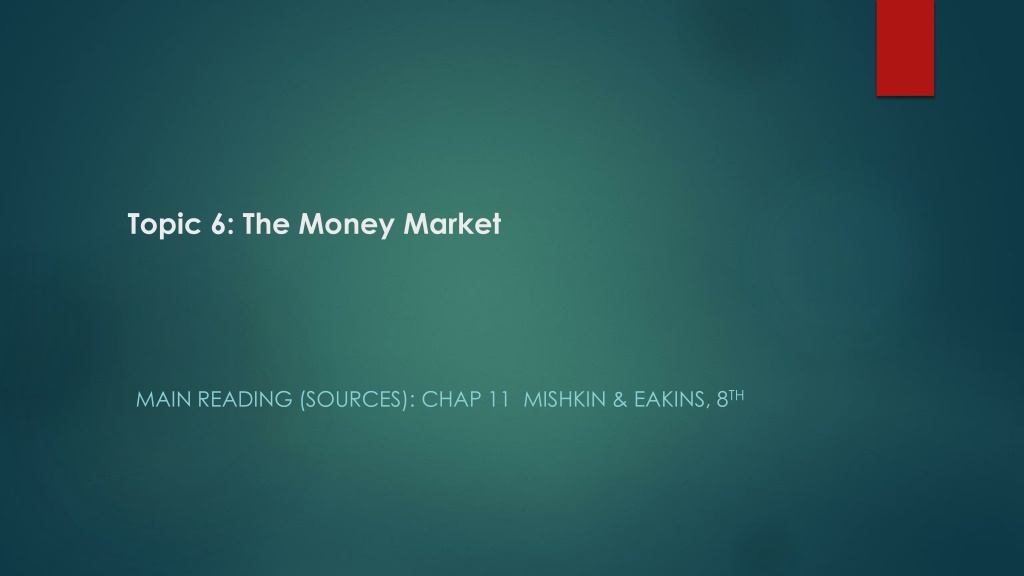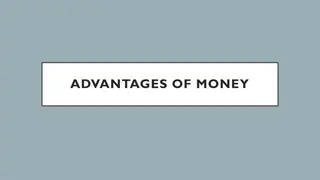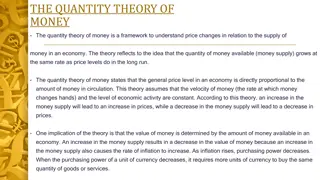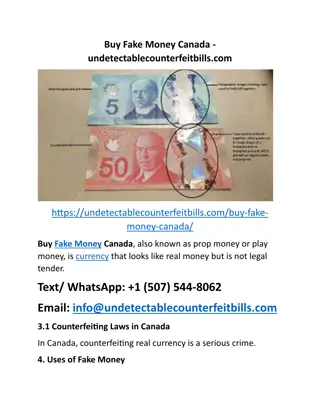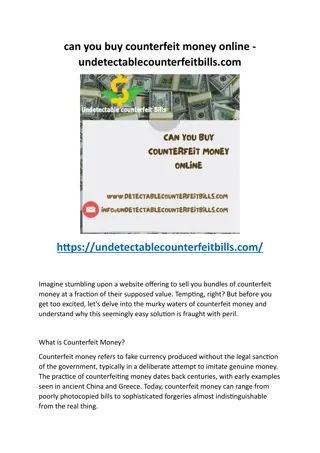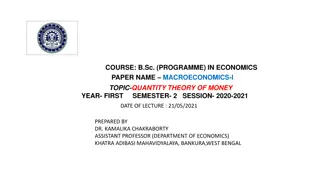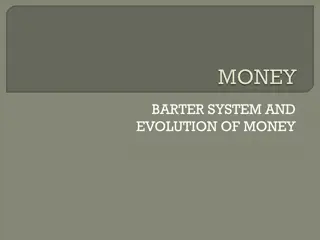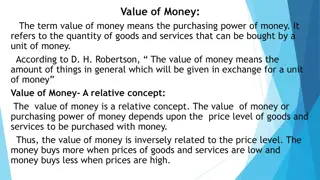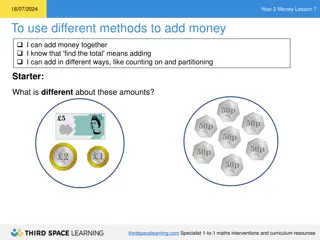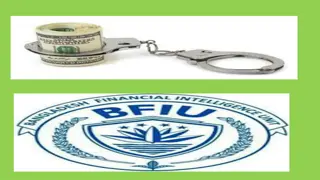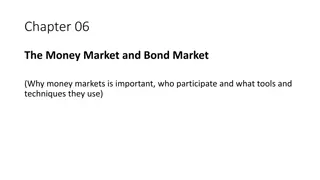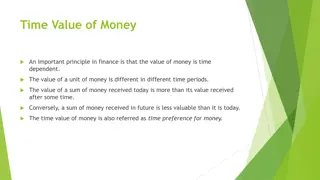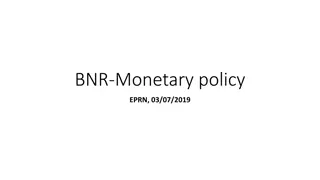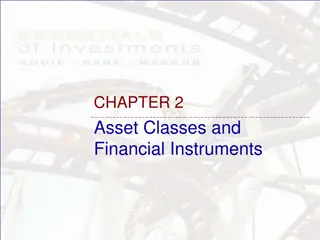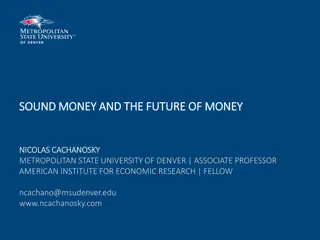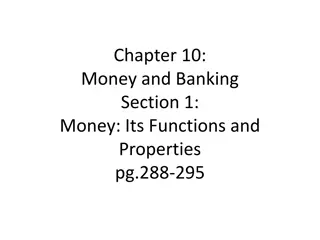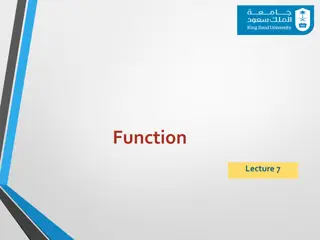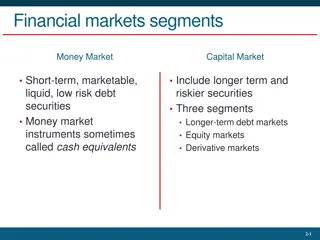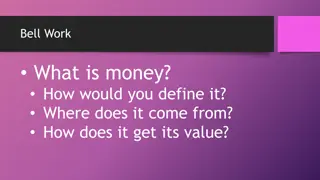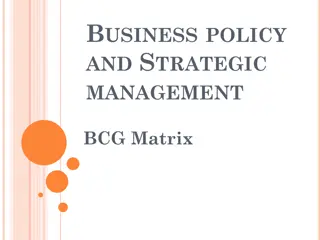Money Market Essentials: Defined, Purpose, Advantages
Fundamentals of the money market, including its definition, importance, participants, and cost advantages over traditional banking. Discover how money markets serve as a vital financial component for investors and borrowers alike.
Download Presentation

Please find below an Image/Link to download the presentation.
The content on the website is provided AS IS for your information and personal use only. It may not be sold, licensed, or shared on other websites without obtaining consent from the author.If you encounter any issues during the download, it is possible that the publisher has removed the file from their server.
You are allowed to download the files provided on this website for personal or commercial use, subject to the condition that they are used lawfully. All files are the property of their respective owners.
The content on the website is provided AS IS for your information and personal use only. It may not be sold, licensed, or shared on other websites without obtaining consent from the author.
E N D
Presentation Transcript
Topic 6: The Money Market MAIN READING (SOURCES): CHAP 11 MISHKIN & EAKINS, 8TH
Chapter Preview We review the money markets and the securities that are traded there. In addition, we discuss why the money markets are important in our financial system. Topics include: The Money Markets Defined The Purpose of Money Markets Who Participates in Money Markets? Money Market Instruments Comparing Money Market Securities
The Money Markets Defined Money Markets Defined Usually sold in large denominations ($1,000,000 or more) 1. Low default risk 2. Mature in one year or less from their issue date, although most mature in less than 120 days 3.
The Money Markets Defined: Why Do We Need Money Markets? The banking industry should handle the needs for short- term. Banks have an information advantage. Banks, however, are heavily regulated. Creates a distinct cost advantage for money markets over banks.
The Money Markets Defined: Cost Advantages Reserve requirements create additional expense for banks that money markets do not have Regulations on the level of interest banks could offer depositors lead to a significant growth in money markets, especially in the 1970s and 1980s. When interest rates rose, depositors moved their money from banks to money markets. The cost structure of banks limits their competitiveness to situations where their informational advantages outweighs their regulatory costs. Limits on interest banks could offer was not relevant until the 1950s. In the decades that followed, the problem became apparent.
Figure 11.1 Three-Month Treasury Bill Rate and Ceiling Rate on Savings Deposits at Commercial Banks, 1933 to 1986 Source: http://www.stlouisfed.org/default.cfm.
The Purpose of Money Markets Investors in Money Market: Provides a place for warehousing surplus funds for short periods of time Borrowers from money market provide low-cost source of temporary funds Corporations and U.S. government use these markets because the timing of cash inflows and outflows are not well synchronized. Money markets provide a way to solve these cash-timing problems.
Table 11.1 Sample Money Market Rates, Feb 22, 2024 Instrument Interest Rate (%) Prime rate 8.50 Federal funds 5.25-5.50 Commercial Paper 5.24 SOFR 5.30 Eurodollar 5.48 Treasury bills (4 week) 5.41
Table 11.2 Money Market Participants (1 of 3) Participant Role U.S. Treasury Department Sells U.S. Treasury securities to fund the national debt Federal Reserve System Buys and sells U.S. Treasury securities as its primary method of controlling interest rates Buy U.S. Treasury securities; sell certificates of deposit and make short-term loans; offer individual investors accounts that invest in money market securities Commercial banks
Table 11.2 Money Market Participants (2 of 3) Participant Businesses Role Buy and sell various short-term securities as a regular part of their cash management Investment companies (brokerage firms) Trade on behalf of commercial accounts Finance companies (commercial leasing companies) Lend funds to individuals Insurance companies (property and casualty insurance companies) Maintain liquidity needed to meet unexpected demands
Table 11.2 Money Market Participants (3 of 3) Participant Pension funds Role Maintain funds in money market instruments in readiness for investment in stocks and bonds Buy money market mutual funds Individuals Money market mutual funds Allow small investors to participate in the money market by aggregating their funds to invest in large- denomination money market securities
Money Market Instruments Money market instruments include: Treasury Bills Federal Funds Repurchase Agreements Negotiable Certificates of Deposit Commercial Paper Banker s Acceptance Eurodollars
Money Market Instruments: Treasury Bills T-bills have 28-day maturities through 12- month maturities. Discounting: When an investor pays less for the security than it will be worth when it matures, and the increase in price provides a return. This is common to short-term securities because they often mature before the issuer can mail out interest checks.
Money Market Instruments: Treasury Bills Discounting Example You pay $996.73 for a 28-day T-bill. It is worth $1,000 at maturity. What is its discount rate? What is its yield to maturity(i.e. investment return)? idiscount= ? iyt=?
Money Market Instruments: Treasury Bill Auctions T-bills are auctioned to the dealers every Thursday. The Treasury may accept both competitive and noncompetitive bids, and the price everyone pays is the highest yield paid to any accepted bid.
Money Market Instruments: Treasury Bill Auctions Example (1 of 2) The Treasury auctioned $2.5 billion par value 91-day T-bills, the following bids were received: Bidder 1 2 3 4 5 Bid Amount $500 million $750 million $1.5 billion $1 billion $600 million Bid Price $0.9940 $0.9901 $0.9925 $0.9936 $0.9939 The Treasury also received $750 million in noncompetitive bids. Who will receive T-bills, what quantity, and at what price?
Money Market Instruments: Treasury Bill Auctions Example (2 of 2) The Treasury accepts the following bids: Bidder Bid Amount Bid Price $0.9940 $0.9939 $0.9936 1 5 4 $500 million $600 million $650 million Both the competitive and noncompetitive bidders are paid at the highest yield based on the price of 0.9936.
Table 11.3 Recent Bill Auction Results Security Term Issue Date Maturity Date Discount Rate Investmen t Rate Price per $100 CUSIP 28 day 5/19/2016 6/16/2016 0.240 0.243 99.981333 912796HX0 91 day 5/19/2016 8/18/2016 0.275 0.279 99.930486 912796HA0 182 day 5/19/2016 11/17/201 6 0.370 0.376 99.812944 912796JU4 28 day 5/19/2016 6/9/2016 0.245 0.248 99.980944 912796HW2 91 day 5/19/2016 8/11/2016 0.240 0.243 99.939333 912796JF7
Figure 11.2 Treasury Bill Interest Rate and the Inflation Rate, January 1973 January 2016 Source: http://www.federalreserve.gov/releases and CPI: ftp://ftp.bls.gov/pub/special.requests/cpi/cpiai.txt.
Mini-Case: Treasury Bill Auctions Go Haywire In 1991, Salomon Smith Barney violated Treasury auction rules to corner the auction on an $11 billion issue. Several top Salomon officials were forced to retire (or fired) as a result of the incident. The Treasury also changed the auction rules to ensure a competitive auction.
Money Market Instruments: Federal Funds Short-term funds transferred (loaned or borrowed) between financial institutions, usually for a period of one day (overnight). They are lent by banks that have an excess of reserves and borrowed by banks that have a deficit of reserves. Used by banks to meet short-term needs to meet reserve requirements.
Figure 11.3 Federal Funds and Treasury Bill Interest Rates, January 1990 April 2016 Source: http://www.federalreserve.gov/releases/h15/data.htm.
Money Market Instruments: Repurchase Agreements These work similar to the market for fed funds, but nonbanks can participate. A firm sells Treasury securities, but agrees to buy them back at a certain date (usually 3 14 days later) for a certain price. This set-up makes a repo agreements essentially a short- term collateralized loan. This is one market the Fed may use to conduct its monetary policy, whereby the Fed purchases/sells Treasury securities in the repo market.
Money Market Instruments: Negotiable Certificates of Deposit A bank-issued security that documents a deposit and specifies the interest rate and the maturity date Denominations range from $100,000 to $10 million
Money Market Instruments: Commercial Paper (1 of 2) Unsecured promissory notes, issued by corporations, that mature in no more than 270 days. The use of commercial paper increased significantly in the early 1980s because of the rising cost of bank loans. Commercial paper volume: fell significantly during the recent economic recession annual market is still large, at well over $0.85 trillion outstanding
Figure 11.4 Return on Commercial Paper and the Prime Rate, 1990 April 2016 Source: http://www.federalreserve.gov/releases/h15/data/Monthly/H15_PRIME_NA.txt.
Money Market Instruments: Commercial Paper (2 of 2) A special type of commercial paper, known as asset-backed commercial paper (ABCP) played a key role in the financial crisis in 2008 backed by securitized mortgages often difficult to understand accounted for about $1 trillion When the poor quality of the underlying assets was exposed, a run on ABCP began. Because ABCP was held by many money market mutual funds (MMMFs), these funds also experienced a run. The government eventually had to step in to prevent the collapse of the MMMF market.
Figure 11.5 Volume of Commercial Paper Outstanding Source: http://www.federalreserve.gov/releases/cp/yrend.htm.
Money Market Instruments: Banker s Acceptances An order to pay a specified amount to the bearer on a given date if specified conditions have been met, usually delivery of promised goods. These are often used when buyers / sellers of expensive goods live in different countries. Banker s acceptances avoid the need to establish the credit-worthiness of a customer living abroad. There is also an active secondary market for banker s acceptances until they mature. The terms of note indicate that the bearer, whoever that is, will be paid upon maturity.
Money Market Instruments: Banker s Acceptances Advantages 1. Exporter paid immediately 2. Exporter shielded from foreign exchange risk 3. Exporter does not have to assess the financial security of the importer 4. Importer s bank guarantees payment 5. Crucial to international trade
Money Market Instruments: Eurodollars Eurodollars represent Dollar denominated deposits held in foreign banks. The market is essential since many foreign contracts call for payment is U.S. dollars due to the stability of the dollar, relative to other currencies. The Eurodollar market has continued to grow rapidly because depositors receive a higher rate of return on a dollar deposit in the Eurodollar market than in the domestic market. Multinational banks are not subject to the same regulations restricting U.S. banks and because they are willing to accept narrower spreads between the interest paid on deposits and the interest earned on loans.
Money Market Instruments: Eurodollars Rates London interbank bid rate (LIBID) The rate paid by banks buying funds London interbank offer rate (LIBOR) switching to Secured Overnight Financing Rate (SOFR) The rate offered for sale of the funds Time deposits with fixed maturities Largest short term security in the world
Global: Birth of the Eurodollar The Eurodollar market is one of the most important financial markets, but oddly enough, it was fathered by the Soviet Union. In the 1950s, the USSR had accumulated large dollar deposits, but all were in US banks. They feared the US might seize them, but still wanted dollars. So, the USSR transferred the dollars to European banks, creating the Eurodollar market.
Comparing Money Market Securities: Table 11.4 Money Market Securities and Their Markets Money Market Security Treasury bills U.S. government companies Federal funds Banks Banks Repurchase agreements and banks banks Issuer Buyer Usual Maturity Secondary Market Excellent Consumers and 4, 13, 26, and 52 weeks 1 to 7 days 1 to 15 days None Good Businesses Businesses and Negotiable CDs Commercial paper Large money center banks Finance companies and businesses Banks Businesses 14 to 120 days Good Businesses 1 to 270 days Poor Banker s acceptances Eurodollar deposits Businesses 30 to 180 days Good Non-U.S. banks Businesses, governments, and banks 1 day to 1 year Poor
Chapter Summary The Money Markets Defined Short-term instruments Most have a low default probability The Purpose of Money Markets Used to warehouse funds Returns are low because of low risk and high liquidity Who Participates in Money Markets? U.S. Treasury Commercial banks Businesses Individuals (through mutual funds) Money Market Instruments Include T-bills, fed funds, etc. Comparing Money Market Securities Issuers range from the US government to banks to large corporations Mature in as little as 1 day to as long as 1 year The secondary market liquidity varies substantially
